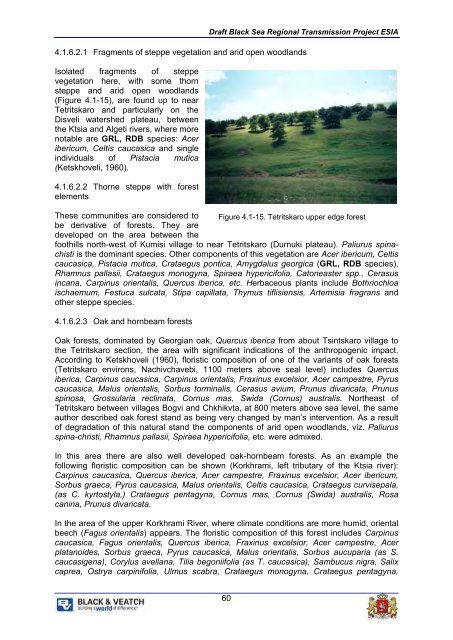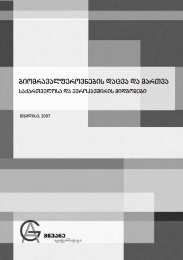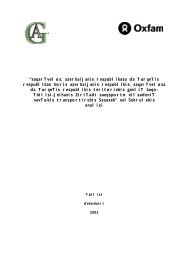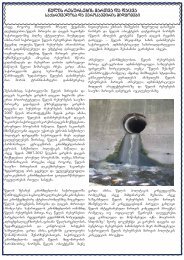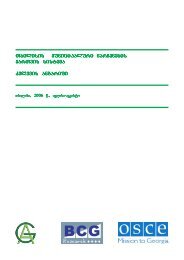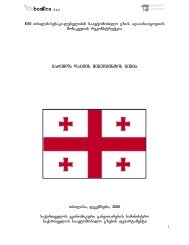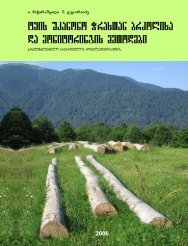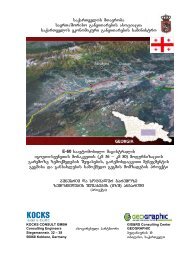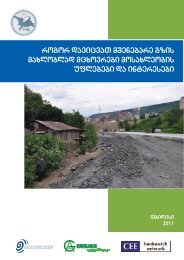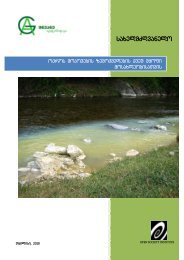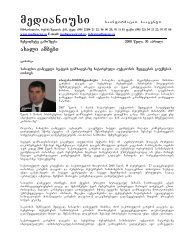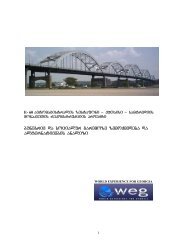Part I
Part I
Part I
Create successful ePaper yourself
Turn your PDF publications into a flip-book with our unique Google optimized e-Paper software.
Draft Black Sea Regional Transmission Project ESIA<br />
4.1.6.2.1 Fragments of steppe vegetation and arid open woodlands<br />
Isolated fragments of steppe<br />
vegetation here, with some thorn<br />
steppe and arid open woodlands<br />
(Figure 4.1-15), are found up to near<br />
Tetritskaro and particularly on the<br />
Disveli watershed plateau, between<br />
the Ktsia and Algeti rivers, where more<br />
notable are GRL, RDB species: Acer<br />
ibericum, Celtis caucasica and single<br />
individuals of Pistacia mutica<br />
(Ketskhoveli, 1960).<br />
4.1.6.2.2 Thorne steppe with forest<br />
elements<br />
These communities are considered to Figure 4.1-15. Tetritskaro upper edge forest<br />
be derivative of forests. They are<br />
developed on the area between the<br />
foothills north-west of Kumisi village to near Tetritskaro (Durnuki plateau). Paliurus spinachisti<br />
is the dominant species. Other components of this vegetation are Acer ibericum, Celtis<br />
caucasica, Pistacia mutica, Crataegus pontica, Amygdalus georgica (GRL, RDB species),<br />
Rhamnus pallasii, Crataegus monogyna, Spiraea hypericifolia, Catoneaster spp., Cerasus<br />
incana, Carpinus orientalis, Quercus iberica, etc. Herbaceous plants include Bothriochloa<br />
ischaemum, Festuca sulcata, Stipa capillata, Thymus tiflisiensis, Artemisia fragrans and<br />
other steppe species.<br />
4.1.6.2.3 Oak and hornbeam forests<br />
Oak forests, dominated by Georgian oak, Quercus iberica from about Tsintskaro village to<br />
the Tetritskaro section, the area with significant indications of the anthropogenic impact.<br />
According to Ketskhoveli (1960), floristic composition of one of the variants of oak forests<br />
(Tetritskaro environs, Nachivchavebi, 1100 meters above seal level) includes Quercus<br />
iberica, Carpinus caucasica, Carpinus orientalis, Fraxinus excelsior, Acer campestre, Pyrus<br />
caucasica, Malus orientalis, Sorbus torminalis, Cerasus avium, Prunus divaricata, Prunus<br />
spinosa, Grossularia reclinata, Cornus mas, Swida (Cornus) australis. Northeast of<br />
Tetritskaro between villages Bogvi and Chkhikvta, at 800 meters above sea level, the same<br />
author described oak forest stand as being very changed by man’s intervention. As a result<br />
of degradation of this natural stand the components of arid open woodlands, viz. Paliurus<br />
spina-christi, Rhamnus pallasii, Spiraea hypericifolia, etc. were admixed.<br />
In this area there are also well developed oak-hornbeam forests. As an example the<br />
following floristic composition can be shown (Korkhrami, left tributary of the Ktsia river):<br />
Carpinus caucasica, Quercus iberica, Acer campestre, Fraxinus excelsior, Acer ibericum,<br />
Sorbus graeca, Pyrus caucasica, Malus orientalis, Celtis caucasica, Crataegus curvisepala,<br />
(as C. kyrtostyla,) Crataegus pentagyna, Cornus mas, Cornus (Swida) australis, Rosa<br />
canina, Prunus divaricata.<br />
In the area of the upper Korkhrami River, where climate conditions are more humid, oriental<br />
beech (Fagus orientalis) appears. The floristic composition of this forest includes Carpinus<br />
caucasica, Fagus orientalis, Quercus iberica, Fraxinus excelsior, Acer campestre, Acer<br />
platanoides, Sorbus graeca, Pyrus caucasica, Malus orientalis, Sorbus aucuparia (as S.<br />
caucasigena), Corylus avellana, Tilia begoniifolia (as T. caucasica), Sambucus nigra, Salix<br />
caprea, Ostrya carpinifolia, Ulmus scabra, Crataegus monogyna, Crataegus pentagyna,<br />
60


